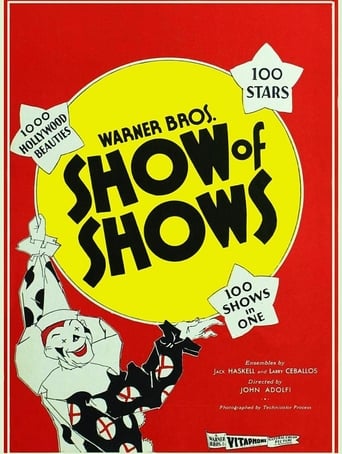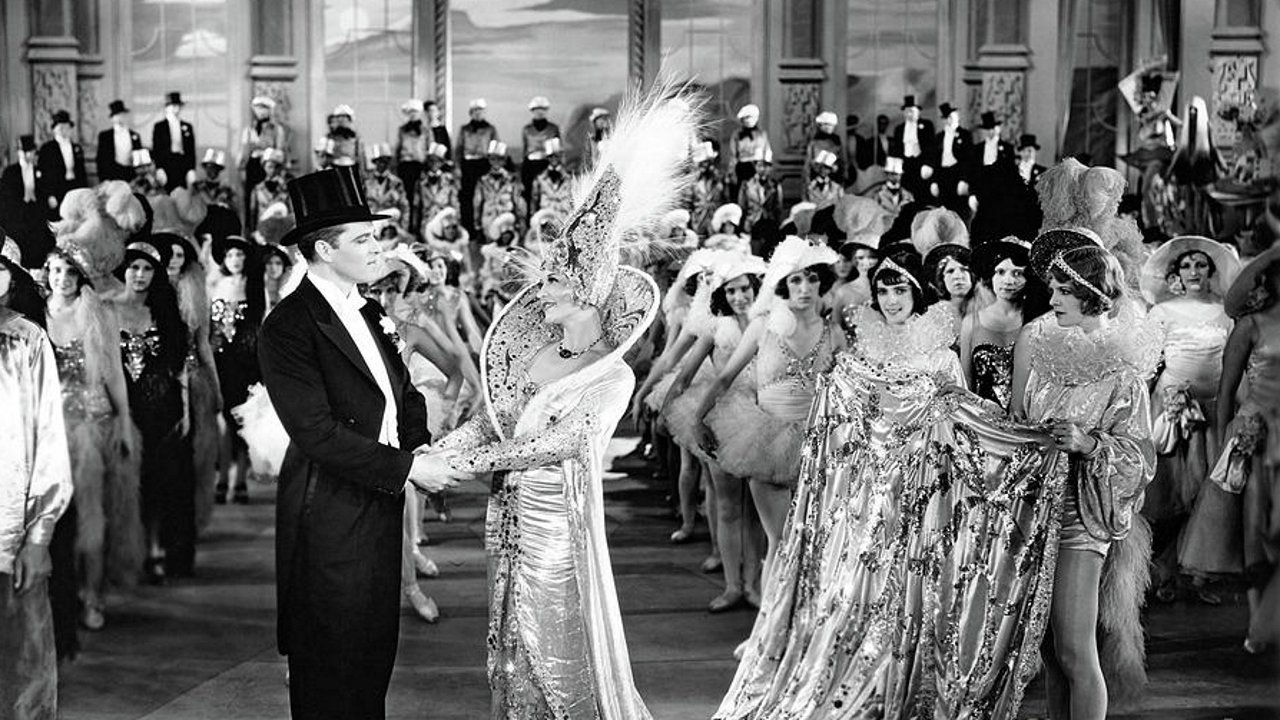fredcdobbs5
As other posters have noted, this is really a difficult film to rate. Judging it by modern standards it's awful--overblown, creaky, flat and primitive--but judging it by 1929 standards I can see where audiences must have bowled over by it. They could see their favorite stars--mostly from the silent days--like they had never seen them before, playing themselves and, in many cases, doing things they had never done, such as singing, dancing and comedy routines. Overall, though, it's poorly staged by director John G. Adolfi, who was not one of Warners' top-rank directors and was known for making "serious" melodramas; why Warners picked him to direct this big, splashy, musical comedy revue is incomprehensible. Whatever the reason, he seems to have functioned more as a traffic cop than a director.Some of the musical numbers are fair to middling, but others are just flat-out embarrassing. Probably the worst routine in the picture is the "Rifle Execution" skit. It's supposed to be funny, but it doesn't even rise to the level of a bad Benny Hill routine. It's utterly, completely and totally unfunny, with nary a laugh, chuckle, smirk or even a titter and is further hampered by the irritating Frank Fay trying to upstage everybody, and failing miserably. It's also in incredibly bad taste; there's nothing funny about a man placed in front of a wall with his hands tied behind his back about to be executed by a firing squad--and at the end of the "skit" he actually is! Unbelievable.The opening number, with 100 or so showgirls doing precision dancing on a huge staircase a la Busby Berkeley, is actually impressive, however; the very intricate routine is shot in one long take and comes off without a hitch. It's pretty much downhill after that, though, except for Winnie Lightner's two musical numbers, which are infectious and enjoyable. Most of the "comedy" routines performed by stars not known for comedy--and even some who are--come across as forced, flat and, even worse, unfunny. Probably the worst "performance", however, is by emcee Frank Fay, a Broadway star of the era. He comes across as an obnoxious ham, his feeble attempts at singing and comic patter are annoying, and his introductions to each of the featured numbers are clumsy, inept and overlong. As an emcee, he is an abysmal flop. Why he was considered a star isn't readily apparent at all.This film is much more valuable as an historical document than as entertainment, which it barely achieves. Many of the stars--70+ of them--I had heard of before but had never seen them in anything (e.g., Lloyd Hamilton, Winnie Lightner, Bea Lillie and Alice Day), so it was at least interesting to finally see them in action, as it were. A young but recognizable Loretta Young and her sister Sally Blane perform in a very strange number that features teams of well-known sisters dressed as "Dutch maids" singing and dancing in a "Ziegfeld Girls" type of big splashy routine. The number also features a young and unrecognizable Ann Sothern, when she was using her real name of Harriet Lake, with her sister Bonnie Lake.The film is a very mixed bag--everybody from John Barrymore to Rin-Tin-Tin puts in an appearance--and difficult to slog through at times, only occasionally rising above mediocrity. Worth a look once for its historical significance, but that's about it.
kidboots
The early all star musicals were designed to show audiences that even the most dramatic of stars could sparkle and captivate with their singing and dancing talent and also was a way to introduce new talent to an unknowing public ("if you like Irene Bordoni's song in "Show of Shows", you will just love her in her new movie "Paris"). They also served as screen tests where silent favourites were thrust in front of the cameras, often with no guidance or help (Clara Bow, who was a real hit in "Paramount on Parade" had to arrange her own hair), then struggled to entertain or wisecrack. Every studio had one in the pipeline, even lowly little Pathe, but they were the first type of musicals to find disfavour with the public. With the success of "The Hollywood Revue of 1929" Warner Bros. decided it, too, must have an all star revue but of the initial lineup only John Barrymore ended up in the movie. Al Jolson was a conspicuous no show, having demanded too much money (besides his last movie "Say It With Songs" was a huge flop). Master of Ceremonies was Frank Fay (at the time married to Barbara Stanwyck) a huge name in vaudeville but in movies his arrogance shone through. There is a running gag about him trying to convince the studio that he can sing - and three quarters of the way through he gets his chance but he has now picked up a side kick in Sid Silvers who does get to do an imitation of Al Jolson and a really awful song about bad breath (I'm not joking) called "If Your Best Friend Won't Tell You".Why, in my opinion, this revue fell flat, as opposed to "Paramount on Parade". Paramount knew the value of it's stars and each of it's numbers had the focus directed on one person (Clara Bow, Helen Kane, Nancy Carroll). "Show of Shows" seemed just a jumble of sketches designed to put as many of it's stars in as the stage would allow. That's why my favourite was Winnie Lightner. She had been a huge hit in "Gold Diggers of Broadway" and at the time probably seemed Warner's best bet for stardom (of course musicals were never going to go out of fashion were they?). She belted her way through "Pingo Pongo" and whether you liked that style or not she carried you through this zany song about cannibals, she looked like she was enjoying herself and actually loved to sing. She was back for another number, a funny parody of "Singin' in the Rain" called "Singin' in the Bathtub", performed in an over-sized bathroom with a male chorus dressed in old fashioned women's bathers. John Barrymore was also a standout and gave audiences a thrill with his Duke of Gloucester soliloquy from "Henry VI" and also a chance to see "the greatest Hamlet of his generation".A most bizarre opening - a nobleman is beheaded while a peasant shouts "On With the Show of Shows" - there follows an amazing precision military formation dance headed by Monte Blue. Next is the amusing "What Became of the Flora Dora Boys" (Myrna Loy, Sally O'Neil are among the girls , the boys are old comedians including Ben Turpin) which would have you believe that while the girls stayed young and beautiful, the boys hit hard times. There was a pirate number where Ted Lewis jazzed the blues away (was he really a popular band leader !!!) Richard Barthelemess introduced "Sisters" in which pairs of famous sisters (there were a few ring ins including Harriette Lake, soon to be Ann Sothern)did little dances in national costumes. I thought the problem with these numbers was even though the stars were introduced there was no individualizing - and it was often hard to pick out who was who. Just when you despaired, along came Rin Tin Tin who introduced "Li Po Li". It is the only Technicolor segment that has survived and it was dazzling - the turquoises, golds and reds were so sharp and striking. Myrna Loy is the Oriental dancing girl and Nick Lucas is the singer, there is a gigantic genie and chorus girls pop out of huge jars. It is all kitsch but wonderful.Irene Bordoni was just a bit too "different" - she sang sensuously "Just an Hour With You" but she was photographed too unflatteringly. Bea Lillie, to me, looked as though she could have been witty and funny in a modern way, was only given a few lines. Another skit in the "different" category - former middleweight fighter Georges Carpentier puts chorus girls through their exercising paces, finishing up climbing ladders where they do their formations on wall niches. The heavily promoted song of the show is "Lady Luck" and the finale, while long, is spectacular. Girls are revealed as human chandeliers as Alexander Gray tries to give the song ("don't give my hopes the razz") a touch of class. Then there come out every conceivable variety act - the floppy girl, the boy who can somersault one way and land the other and beautiful Armida who runs down the steps for a cute hip swinging dance."The Advent of a New Event in Pictures" was the slogan Warners used and at $800,000 it was their most expensive film (excepting "Noah's Ark"). It had everything, even a bathtub, but originality and proved that there was no place for revues as films it they didn't have style and class.
eocostello
One of a handful of "revue" films from the early sound era, this film mixes musical numbers and comedy routines, a la vaudeville. Some items don't really work, in particular Frank Fay's role as emcee, and the finale, which is rather loosely structured. On the other hand, Winnie Lightner does two terrific turns, especially with "Singin' in the Bathtub," which is put over with punch. Some versions have the "Li-Po-Li" segment in 2-strip Technicolor, which gives the routine unusual sheen and polish, playing off the strengths of the system, especially in the use of turquoises and reds.Generally superior, I think, to MGM's "Hollywood Revue of 1929," and worth watching if you can
Mossy-8
This is hardly a movie at all, but rather a real vaudeville show, filmed for the most part "in proscenium", and starring some of the greatest stage stars of the day. "Singing in the Bathtub" is an absolutely amazing production number that must be seen-- be sure to wear your shower cap!


 AD
AD



